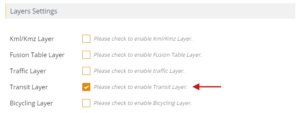
Step 1: Obtain a Google Maps API Key
Before you start, ensure you have a Google Maps API key. If you don’t have one, follow these steps to get it:
- Sign In to Google Cloud Console
- Visit the Google Cloud Console and sign in with your Google account.
- Create or Select a Project
- Create a new project or select an existing one from the project drop-down menu.
- Enable Google Maps JavaScript API
- Navigate to APIs & Services > Library.
- Search for Maps JavaScript API and click Enable.
- Generate an API Key
- Go to APIs & Services > Credentials.
- Click Create Credentials and select API Key.
- Copy the generated API key for use in your application.
Step 2: Set Up Your HTML and JavaScript
- Create an HTML File
- Open your text editor and create a new HTML file, such as
index.html.
- Open your text editor and create a new HTML file, such as
- Add Basic HTML Structure
- Use the following code to set up a basic map with layer configuration:
html
<!DOCTYPE html>
<html lang="en">
<head>
<meta charset="UTF-8">
<meta name="viewport" content="width=device-width, initial-scale=1.0">
<title>Map Layers Configuration</title>
<style>
#map {
height: 100vh; /* Full height of the viewport */
width: 100%; /* Full width */
}
.controls {
margin: 10px;
}
</style>
</head>
<body>
<h1>Configure Map Layers</h1>
<div class="controls">
<button onclick="toggleTrafficLayer()">Toggle Traffic</button>
<button onclick="toggleTransitLayer()">Toggle Transit</button>
<button onclick="toggleBicyclingLayer()">Toggle Bicycling</button>
</div>
<div id="map"></div>
<script>
var map;
var trafficLayer;
var transitLayer;
var bicyclingLayer;function initMap() {
// Initialize the map
map = new google.maps.Map(document.getElementById('map'), {
center: { lat: 40.730610, lng: -73.935242 },
zoom: 12
});// Initialize the Traffic Layer
trafficLayer = new google.maps.TrafficLayer();// Initialize the Transit Layer
transitLayer = new google.maps.TransitLayer();// Initialize the Bicycling Layer
bicyclingLayer = new google.maps.BicyclingLayer();
}function toggleTrafficLayer() {
if (trafficLayer.getMap() === null) {
trafficLayer.setMap(map);
} else {
trafficLayer.setMap(null);
}
}function toggleTransitLayer() {
if (transitLayer.getMap() === null) {
transitLayer.setMap(map);
} else {
transitLayer.setMap(null);
}
}function toggleBicyclingLayer() {
</script>
if (bicyclingLayer.getMap() === null) {
bicyclingLayer.setMap(map);
} else {
bicyclingLayer.setMap(null);
}
}
<!-- Load the Google Maps JavaScript API -->
<script src="https://maps.googleapis.com/maps/api/js?key=YOUR_API_KEY&callback=initMap" async defer></script>
</body>
</html>
- Replace
YOUR_API_KEYwith your actual API key.
- Use the following code to set up a basic map with layer configuration:
Step 3: Understanding the Code
- HTML Structure
- The
<style>section ensures that the map takes up the full viewport height and width. - The
<div id="map"></div>is where the map will be displayed. - The
<div class="controls">contains buttons to toggle different map layers.
- The
- JavaScript for Map Layers
- The
initMapfunction initializes the map and creates instances of the Traffic, Transit, and Bicycling layers. - The
toggleTrafficLayer,toggleTransitLayer, andtoggleBicyclingLayerfunctions toggle the visibility of the respective layers on the map.
- The
- Google Maps API Script
- The
<script>tag loads the Google Maps JavaScript API and executes theinitMapfunction once the API has loaded. Theasyncanddeferattributes ensure the script is loaded asynchronously and executed after the page is fully loaded.
- The
Step 4: Test Your Implementation
- Save and Open Your HTML File
- Save your changes and open
index.htmlin a web browser.
- Save your changes and open
- Verify Layer Configuration
- Ensure that the map loads correctly with the ability to toggle Traffic, Transit, and Bicycling layers on and off using the buttons.
Step 5: Advanced Configuration
- Layer Customization
- You can customize the behavior of each layer by configuring additional options or integrating with other APIs.
- Integration with Other Map Features
- Combine layer toggling with other map features like markers, info windows, or custom controls to create a more interactive and feature-rich application.
Conclusion
Configuring map layers such as Traffic, Transit, and Bicycling in Google Maps adds valuable functionality to your web applications, providing users with real-time and relevant information. By following this guide, you can effectively integrate and manage these layers, enhancing the usability and interactivity of your maps. Experiment with different configurations and additional features to tailor the map experience to your needs.











